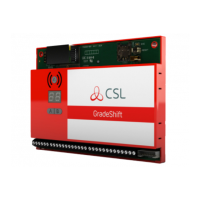EN50131 : PD6662 Connections
Path Fault Conditions
Where the installation is specified to the EN 50131 and PD6662 standards then
connections will be required between the DualCom and the Control Panel to
indicate a single or a multiple path fault condition.
The Fault (and Aux) relay output(s) are used for this. These outputs may be
preset to operate in one of 3 ways as shown below. Check which method(s) are
available on your Control Panel and connect as required.
a). Fault relay = Operates as described in BSIA Form 175, Aux relay = unused.
b). Fault relay = Radio path fault, Aux relay = Wired path fault.
c). Fault relay = multiple path fault, Aux relay = single path fault.
Select the Fault & Aux Relay Output options using the A & B buttons. See the
Fault & Auxilliary Relay Output section, and Appendix 1, Tables 30, 31 & 32.
The Fault & Aux Relay Outputs options may also be selected using the CS0054
Programmer. See the CS0054 and the CS2364 Programmer manuals.
Where the ‘BSIA Form 175 operation’ is selected above, then a corresponding
‘ATS Test’ output from the Control Panel to the DualCom will be required. For
‘ATS Test’ output connections and the Input Learning feature see Remote Serv-
icing below.
Contact CSL Technical Support for Outputs, Programming or further advice.
Remote Servicing
EN 50131 and PD6662 standards describe Remote Servicing. Where the Con-
trol Panel needs to trigger the DualCom to send test calls to the ARC, the Test
output on the Control Panel will need to be connected to the DualCom. This
connection is also required when ‘BSIA Form 175 operation’ is required for fault
operation.
Depending on the type of Control Panel used (and/or the wiring connection), the
‘ATS Test’ output may be a voltage output that changes from 0 volts to a posi-
tive voltage (5v to +30v), or it may change from a positive voltage to 0 volts.
Connect the Control Panel ‘ATS Test’ output to the DualCom’s ‘ATS Test’ input
on the ‘T’ terminal (next to the Input 8 terminal).
Where the DualCom ‘T’ input is used, the polarity will be correctly preset (as
well as all the channel inputs) using the Input Learning feature. See Appendix 2.
30

